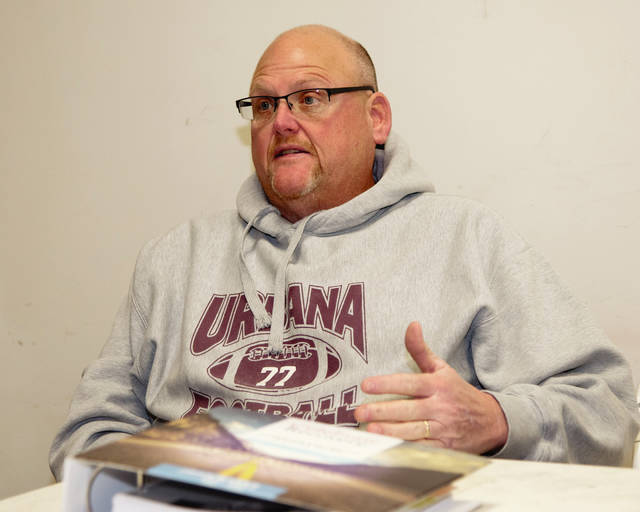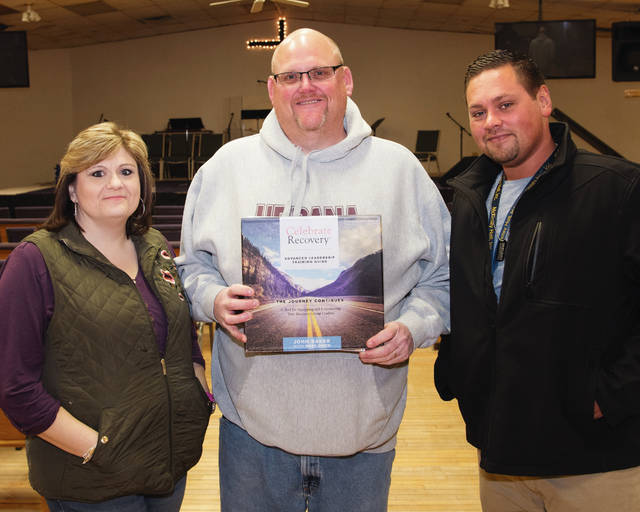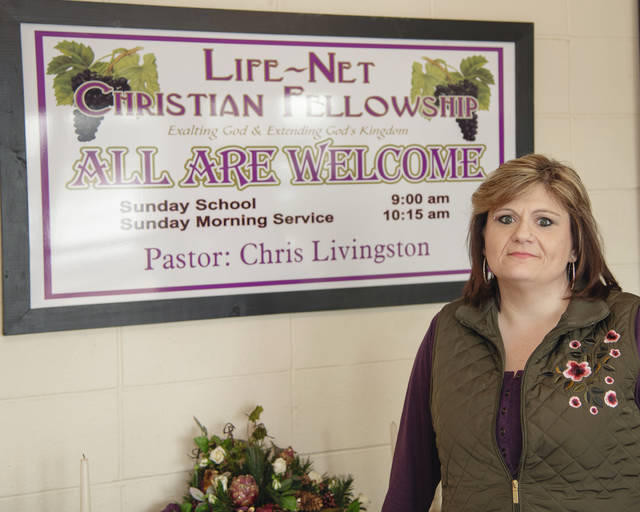



The use of fentanyl had a major impact on Champaign County in 2017 as opioid use in the county continued to affect lives and agencies.
Champaign County Coroner Dr. Joshua Richards said he investigated 16 drug overdose deaths in the county in 2017, up from 11 in 2016. Of these 16 deaths, Richards said 15 involved opioids.
Fourteen of the overdose deaths involved fentanyl or fentanyl analogs, which Richards said are drugs with similar chemical structure and generally have a higher potency. The other opioid death from last year involved a prescription opiate and the other drug overdose death was due to a combination of cocaine and benzodiazepines.
“Surprisingly, none of the cases I investigated (in 2017) had heroin in their system,” Richards said. “This is different from three or four years ago when it was more heroin and not as much fentanyl.”
Richards said he has been told opioid users prefer fentanyl to heroin because it has a stronger potency, while dealers are able to get it because it is synthetically produced, inexpensive and keeps users hooked longer.
“Besides the opioid drugs, I am seeing a resurgence of cocaine and methamphetamine showing up in toxicology screens,” Richards noted. “Marijuana was present in half of those who died due to overdose.”
Champaign County’s autopsies are sent to the Montgomery County coroner’s office.
The Mental Health, Drug and Alcohol Services Board of Logan and Champaign Counties is designed to plan, fund, and evaluate alcohol, drug addiction and mental health treatment, prevention, education and consultation services for Logan and Champaign County residents in accordance with the Ohio Revised Code and the rules and regulations established by the Ohio Department of Mental Health and Addiction Services.
Stacey Logwood, the board’s director of community development, said the board uses coroner records to determine the number of drug overdoses in the county.
“The problem with the numbers though is unless you die in our county, it doesn’t count in our county,” Logwood said. “We have a lot of individuals who will be going to Springfield or Dayton to get their drugs and they will overdose in Springfield or Dayton and that counts in their county’s numbers even though they’re a Champaign County resident. That for us is difficult and not something that we are thrilled about because we feel like we don’t have an accurate portrayal in terms of the numbers.”
Logwood said about half of the overdose deaths in the last seven years have been in the Mechanicsburg area and starting to seep into North Lewisburg. She said the board has tried to follow this through obituaries but this can be difficult if there are no obituaries or funeral services held.
“We really then rely on the coroner’s office but they’re plagued with the fact that Montgomery County is so far behind because every community is sending bodies to be examined through autopsy and so sometimes it’s months of waiting before we get official results,” Logwood said.
Logwood said the board started seeing drug numbers change in 2012. At that time, Logwood said prescription pills were leading to heroin use.
As laws tightened in Ohio regarding the dissemination of prescription pills, Logwood said a long-term heroin issue was anticipated due to the chemical structure similarities.
“For people who have already developed an addiction to prescription opioids if you take those opioids away and heroin is available then people are going to go to heroin because it’s the exact same structure,” Logwood said. “What we didn’t anticipate ever was fentanyl coming into the community.”
Fentanyl
The county’s opioid problem is one felt across Ohio and the nation.
During a Jan. 25 hearing of the U.S. Senate Permanent Subcommittee on Investigations, Sen. Rob Portman outlined the country’s continuing opioid epidemic and the impact it has had on Ohio.
Portman, the chair of the subcommittee, was speaking on a Senate investigation into how easy it was to find fentanyl online from Chinese laboratories that are then shipped via mail services. A Senate report detailing the results of this investigation states the subcommittee identified more than 500 financial transactions by more than 300 U.S. based individuals totaling $230,000 to six online sellers. The 300 individuals were located in 43 states with buyers in Ohio, Pennsylvania and Florida making the highest number of purchases.
Information in the report from the Centers for Disease Control (CDC) states nearly 63,600 people died in 2016 from drug overdoses and 66 percent of those deaths were a result of opioids including fentanyl and its many analogues. In 2015, 63 percent of drug overdose deaths were a result of opioid overdoses.
“These overdose deaths are shocking, the number of deaths continue to grow,” Portman said during the hearing. “My own home state of Ohio we were told recently is now second in the country in terms of overdose deaths – it’s heartbreaking and increasingly these overdoses are due to a synthetic heroin, illegal versions of fentanyl, a drug that is 50 to 100 times stronger than heroin. In fact in Ohio, fentanyl and its variations were involved in 60 percent of the overdose deaths last year so it’s become the number one killer in Ohio.”
According to the CDC’s website, fentanyl is a synthetic opioid that is 50 times more potent than heroin and 100 times more potent than morphine. The two types of fentanyl are pharmaceutical fentanyl, which is primarily prescribed to manage acute and chronic pain associated with advanced cancer, and non-pharmaceutical fentanyl, which is illicitly manufactured and often mixed with heroin or cocaine with or without the user’s knowledge to increase the drug’s effect.
Trickle down effect of opioids
Opioid use in Champaign County continued to have an impact on a number of agencies in 2017.
Through August 2017, Mercy Health-Urbana Hospital had seen 95 patients come to the emergency department for drug overdoses according to information provided by Nanette Bentley, Mercy Health Director of Public Relations. The hospital saw 123 patients come to the emergency department for drug overdoses in 2016 and 202 in 2015.
Local law enforcement has also been impacted by drug overdoses.
According to information provided by Urbana Police Chief Matt Lingrell, the Urbana Police Division investigated 57 drug overdoses in 2017 including seven deaths.
Sheriff Matt Melvin said the Champaign County Sheriff’s Office responded to four deaths from drug overdoses and to 13 calls of non-fatal overdoses in 2017.
Foster care
An agency greatly affected by opioid use in 2017 was the county’s foster care system – increasing the number of children entering foster care and the amount of money used for child care.
Stacy Cox, Social Services Administrator for the Champaign County Department of Job and Family Services, said children enter custody when the agency receives a referral or call alleging abuse or neglect of a child. The referral goes through a screening process to determine whether it meets state guidelines or not and whether the agency intervenes.
For cases where the agency intervenes, Cox says they are assigned to conduct an investigation and assess child safety. In the assessment process, if a child is found to be unsafe, a safety plan is developed to identify a safe person for the child to go to.
“When we’re unable to get a safety plan accomplished, we contact the Champaign County Prosecutor’s Office, we share the concerns, the information that has been gathered, the reasons why we feel the child cannot be left in the home and that the child would be at imminent risk,” Cox said.
The prosecutor’s office would then present the information to the Champaign County Family Court to request an ex parte or emergency order of custody.
If a child enters custody through an ex parte, Cox said the agency is required to find a foster home.
Cox said in 2015 seven children entered into foster care, in 2016 11 children entered into foster care and in 2017 20 children entered into foster care.
“We’ve had a huge increase in the number of kids (entering foster care) from 11 in 2016 to 20 in ‘17 and 11 was high for us in ‘16 so we started to see the spike right there,” Cox said.
Cox said of the 20 children who entered foster care in 2017, 95 percent entered custody as the result of drug abuse issues. In 2016, 27 percent of children entered custody as the result of drugs, 43 percent in 2015 and 38 percent in 2014.
The increase in the number of children entering foster care has affected the agency financially as the amount of money being invested in the cost of care for children has increased. In 2017, Cox said the cost for children in foster care was $906,000 up from $479,000 in 2016.
Cox said the cost of care includes reimbursements to foster parents for daily needs, costs to the agency which licenses foster homes and miscellaneous costs.
As a result of the increase in the number of children entering foster care, Cox said the number of children in the permanent custody of the agency has also increased. When a child is in permanent custody, Cox said all parental rights have been severed and the child will not return to their parent or previous caregiver.
“In 2016 at the end of the year we had four children in permanent custody,” Cox said. “At the end of the year in 2017 we had nine children in permanent custody, awaiting a court hearing for a request for an additional three and in addition to those three we’re in the process of getting ready to file on three more.
“Children are staying in care longer, they’re unable to reunify because the recovery process is a long process and we are bound by timelines that are federal timelines where we are required to seek permanency at 12 months and no later than 24 (months).”
While the number of children entering foster care has increased, Cox said the agency does a lot of upfront work in trying to find relatives to avoid this. She said the percent of children who go with relatives when they are found to be unsafe in their homes has ranged between 50 to 70 percent while 30 to 50 percent enter the agency’s custody.
“When I talk about 20 entering custody in 2017, there were many more children out there that could not remain in their own home that had relatives that were safe and appropriate to care for them,” Cox said.
Cox said working to get more foster homes in Champaign County is a big effort for the agency.
Moving forward, Cox said the agency is trying to learn from 2017’s increase to better prepare if the drug use trend continues.
“It hit us so fast and furious that we were not prepared,” Cox said. “All we can do is learn from the past year and assess and say ‘what is it that we could’ve done better or differently’ and work on addressing those issues based on past experience.
“One of the biggest issues was the lack of foster homes in close proximity so now we’re working to prepare and try to get more folks here to become licensed. Preparing our staff for ideally quicker identification of issues related to substance abuse and referrals to services before it gets to an emergency.”
Celebrate Recovery
In Urbana, a recently formed ministry is looking to provide help for drug use among other addictions.
Pastor Chris Livingston said Celebrate Recovery is a 12-step recovery program aimed at people’s hurts, habits and hang-ups. Livingston, who is an assimilation coach for the program, said Celebrate Recovery is a national program developed by Pastor Rick Warren of the Saddleback Church.
Chris Worthen is the executive director of Urbana Hands of Hope, a non-profit organization that advocates for people in recovery and to help those struggling with addiction to be successful in long term recovery. Worthen said around two years ago he and Livingston attended a seminar where a Celebrate Recovery representative was in attendance.
Worthen said they obtained the literature for the program and studied it for over a year.
The program started meeting locally last October and Livingston said ministry leader Niki Gerard’s experience with the program has provided a more exact way to run the program.
The program meets every Thursday at 6:30 p.m. at the Life Net Christian Fellowship, 142 Dellinger Road.
“We started this whole process by just being part of Tri-County Jail and West Central and we started seeing that most of the problems and most of the hurts, habits and hang-ups stemmed from alcohol and drug dependency and then in the last couple of years it’s been this opioid explosion,” Livingston said. “We’ve watched people come out of Tri-County Jail, come out of West Central in Marysville which is drug rehab, and come back into our community and not have a real place where they can find solutions to their hurts, habits and hang-ups.”
Gerard said the program addresses all of life’s issues including drugs, alcohol, sex, gambling and other addictions as well as other life obstacles. She said each meeting has a lesson on one of eight principles on the Road to Recovery. For example, the principle discussed during the Jan. 25 meeting was hope.
The meetings eventually break into two private sections for men and women where the evening’s lesson is further discussed. Gerard said the private groups is where the healing starts as it allows people to open up.
While the process of the local program started with people coming out of jail or rehabilitation, Livingston said the need goes beyond that.
“The opiate addiction, it doesn’t have a classification,” Livingston said. “It affects everybody, everywhere. I guarantee every person in Urbana knows someone that has this opioid problem or it’s affected someone in their circle of people.”
Gerard said she is a recovering opioid user who has been clean for two years.
“Fentanyl and I were married to each other for a while,” Gerard said.
After going through treatment, Gerard got involved with the Celebrate Recovery program in Enon and said her life has been different ever since.
“I had a relationship with Christ for a while and this was one of the first places where I was able to really learn how to put my faith into daily practice,” Gerald said. “We have found a lot of people actually talk about some of the consequences of active addiction are that it’s a struggle to live your life according to your own belief system. They come in here and find out that we have that same belief system and we have a solution.”
A key to developing the program is relationship building. Livingston said a trust has to be built up with people when they come to the program and the group has tried to develop a safe, secure place.
Livingston said it is important to have the faith community address drug use.
“People need to feel like they belong and they haven’t necessarily been able to do that in the mainstream church but the community and the faith based community is trying to get to a place where we’re letting that stigma of addiction to say ‘hey who cares, everybody needs Jesus, everybody needs a place where they can feel welcome, everybody needs a place where they can feel like they belong,’” Livingston said.





